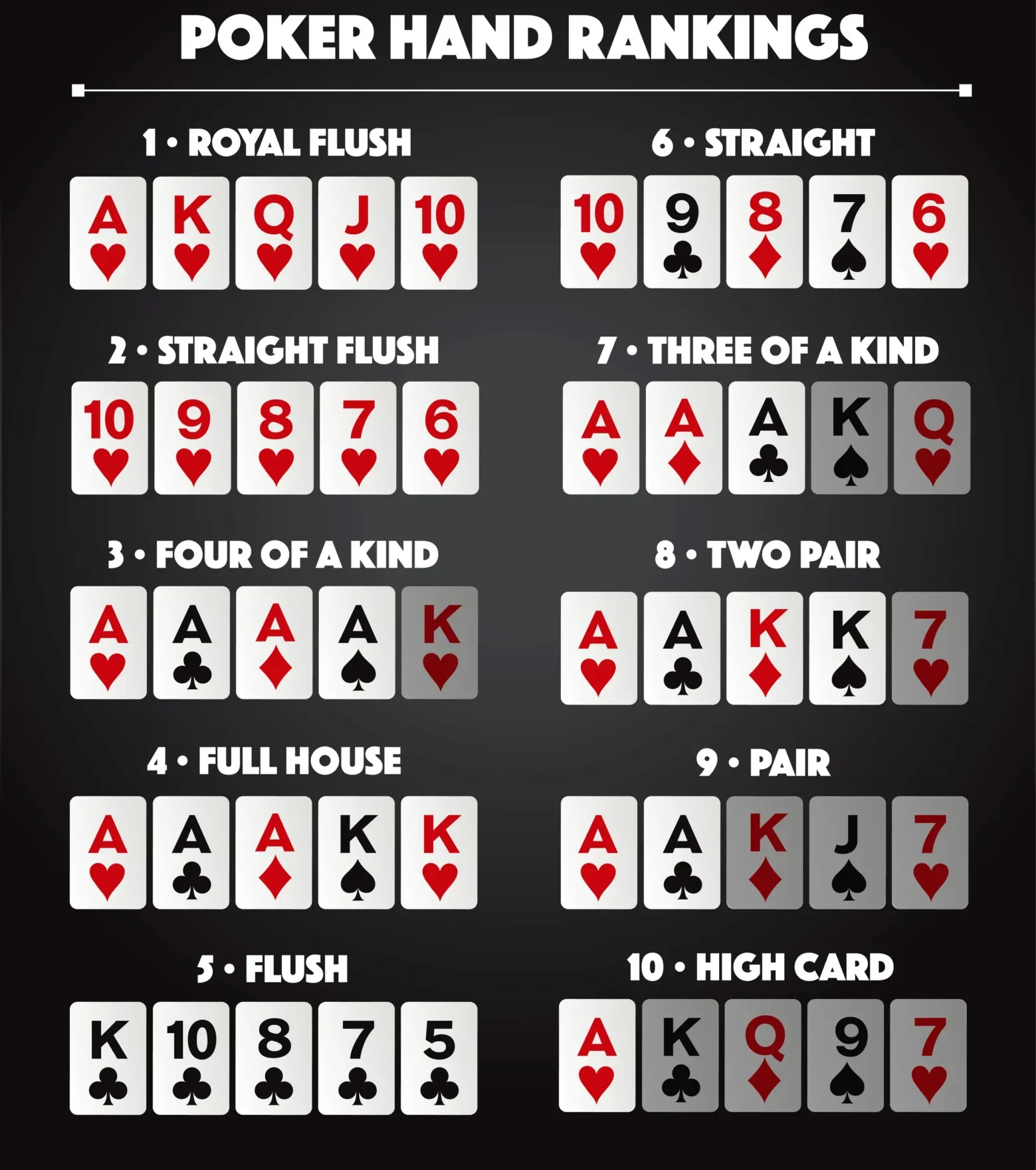Poker isn’t just a game—it’s a way of life. Whether you’re just learning the ropes or you’ve been around the felt a few times, mastering the basics is as important as perfecting your bluff. In this guide, I’m laying out everything you need to know: from the rules and hand rankings of Texas Hold’em to selecting the right starting hands—and yes, even explaining terms like “suited connectors” that might sound fancy to beginners. So pull up a chair, grab a chip or two, and let’s get into it.
Table of Contents

1. The Foundation: Understanding Poker Hand Rankings and Rules

Before you can outsmart your opponents, you need to know the language of the game. Here are the standard poker hand rankings—from the worst to the very best:
- High Card
When you don’t have any combination, the highest card in your hand wins. For example, an Ace-high (A♠, J♦, 8♣, 5♠, 3♥) beats a King-high hand. - One Pair
Two cards of the same rank (e.g., K♠, K♦, 9♣, 7♥, 4♠). - Two Pair
Two different pairs (for example, Q♣, Q♦, 8♠, 8♥, 3♦). If players tie with two pair, the highest pair, then the second pair, and finally the kicker (the extra card) determine the winner. - Three of a Kind (Trips or a Set)
Three cards of the same rank (like 7♥, 7♠, 7♦, K♣, 4♠). Note: When you hit three of a kind using your pocket pair plus one on the board, that’s called a “set”—a subtly deceptive hand. - Straight
Five consecutive cards in sequence, regardless of suit (e.g., 9♣, 10♦, J♠, Q♥, K♣). The Ace can count high (10–J–Q–K–A) or low (A–2–3–4–5), but it can’t “wrap around.” - Flush
Any five cards of the same suit, not in sequential order (such as A♥, J♥, 8♥, 5♥, 2♥). When two players have a flush, the one with the highest card wins. - Full House
A combination of three of a kind and a pair (for instance, 10♣, 10♦, 10♥, 8♠, 8♦). Full houses beat a flush but lose to four-of-a-kind. - Four of a Kind (Quads)
Four cards of the same rank (say, Q♣, Q♦, Q♥, Q♠, 3♥). The kicker—the extra card—determines the winner if two players hold quads. - Straight Flush
Five consecutive cards of the same suit (like 7♣, 8♣, 9♣, 10♣, J♣). The highest straight flush is known as a Royal Flush (10, J, Q, K, A of the same suit), the best hand in poker.
Understanding these combinations is the first step in learning not just the rules, but also how to value your hand in any given situation.
2. Texas Hold’em Basics: Rules and Gameplay
Texas Hold’em is the most popular poker variant in casinos and home games alike. Here’s a quick rundown of how it’s played:
- The Deal & Hole Cards:
Each player is dealt two private cards (your “hole cards”). These are yours and yours alone until the showdown. - The Blinds:
The game uses forced bets called the small blind and big blind. These bets ensure there’s always money in the pot to play for. The dealer button rotates clockwise, so every player takes turns posting blinds. - The Community Cards:
Five community cards are dealt in stages:- Flop: The first three community cards are placed face-up.
- Turn: A fourth card is dealt.
- River: The final, fifth card is dealt.
- Players combine these community cards with their hole cards to make the best five-card hand.
- Betting Rounds:
There’s a round of betting after the hole cards are dealt (pre-flop), after the flop, after the turn, and finally after the river. The goal is to build the pot when you believe you have the best hand or to force your opponents to fold. - The Showdown:
If more than one player is still in after the final betting round, everyone reveals their hand, and the best five-card combination wins the pot.
Even if you’re playing other poker variants—like Omaha (where you get four hole cards and must use exactly two) or Five Card Draw (where you get five cards and can exchange some)—the basics of hand rankings still apply.
3. Starting Hand Selection: What Works and What’s “Suited Connectors”
Now, let’s talk about the hands you should play from the start. This is where many beginners get confused. Here’s what you need to know:
- Premium Hands:
Hands like pocket Aces, Kings, Queens, or Ace-King (especially suited) are the bread and butter of any winning strategy. They’re your foundation for serious play. - Suited Connectors:
These are consecutive cards of the same suit (for example, 7♥–8♥ or J♠–10♠). Suited connectors are valuable because they offer the chance to make a straight or a flush. However, if you’re just starting out, it might be wise to stick with the premium hands until you’re comfortable reading the table and understanding pot odds. - Other Hands:
Hands like pocket pairs (even lower pairs like 5-5 or 6-6) and high card combinations can be profitable, but always consider your position at the table. Early position calls for tighter (fewer) hands, while late position lets you play a wider range.
It’s all about discipline. Good players know that playing too many hands is a fast track to losing chips. The key is to play strong hands aggressively and to know when to fold the rest.
4. Betting, Reading Opponents, and Advanced Bluffing
Once you’ve got the basics down, it’s time to talk strategy—specifically, how to bet and how to bluff.
The Art of Betting
Your bets are your message. They signal strength, uncertainty, or even a clever bluff.
- Value Betting: When you have a strong hand, bet enough to build the pot but not so much that you scare away callers.
- Continuation Bets: If you raised pre-flop, a follow-up bet on the flop (even if you haven’t improved) can often force opponents to fold.
Reading Your Opponents
Over the years, I’ve learned that every player has tells—little clues that reveal what they might be holding. Look for changes in posture, timing, and bet sizing. For example, a player who suddenly bets big might be trying to push a bluff, or they might have hit a monster hand.
Advanced Bluffing Techniques
Bluffing is more than just lying about your hand—it’s about storytelling. You need to convince your opponents that your hand is stronger than it really is. Here’s how:
- Timing: Bluff when the board favors a range of strong hands. If the community cards are scary (like three of a kind on board), your bluff might get away.
- Table Image: If you’ve been playing tight, your occasional big bet carries more weight.
- Risk Management: Don’t bluff too often. Even the greatest players like Stu Ungar, Johnny Chan, or Phil Ivey use bluffs sparingly and only when the situation is right.
Real-Life Example
I remember one hand when I was in a cash game—holding a modest pair of 8s on a board that showed A-5-2. I sensed my opponent was weak; he checked repeatedly. I made a sizable raise, and after a moment’s hesitation, he folded. It wasn’t about having the best hand that day—it was about reading the table and forcing the right move.
5. Learning and Improving at the Tables
Remember, poker is a game of continuous learning. Even legends had to start at the bottom. Here are a few final thoughts:
- Practice at Reputable Sites:
While playing live at a casino is fantastic, online platforms (including non Gamstop casinos) offer a great way to hone your skills without risking too much at first. These sites provide a safe environment to learn and practice. - Study the Game:
Read books, watch videos, and review your own hands. Knowledge is power, and every chip you win starts with a decision made at the table. - Learn from the GOATs:
Study the styles of players like Johnny Chan, Phil Ivey, Daniel Negreanu, and of course, Doyle Brunson. We all had our ups and downs, but the common thread is our dedication to understanding every facet of the game.
Where to Play Texas Hold’em If You’re on GamStop
If you’re currently self-excluded through GamStop but still want to enjoy Texas Hold’em online, there are safe, international poker rooms that accept UK players. These poker sites not on GamStop offer real-money games, generous bonuses, and full access without UKGC restrictions.
From fast-paced Sit & Gos to deep-stack MTTs, these sites provide everything a Texas Hold’em player needs—including flexible banking options like crypto and e-wallets.
👉 Explore the Best Poker Sites Not on GamStop to find trusted platforms reviewed by our expert team.
Conclusion
Poker is a blend of math, psychology, and courage. Whether you’re a beginner just learning the rules or a seasoned player fine-tuning your bluff, never lose sight of the fundamentals. Understand your hand rankings, be disciplined in your starting hand selection, and always be aware of your position and your opponents’ tendencies. With practice—whether at your local table or online at trusted non Gamstop casinos—you’ll find that the game is as much about self-improvement as it is about winning chips.
So, take these tactics, sit down at the table, and remember: poker isn’t just about the cards you’re dealt—it’s about the moves you make. Happy playing!


